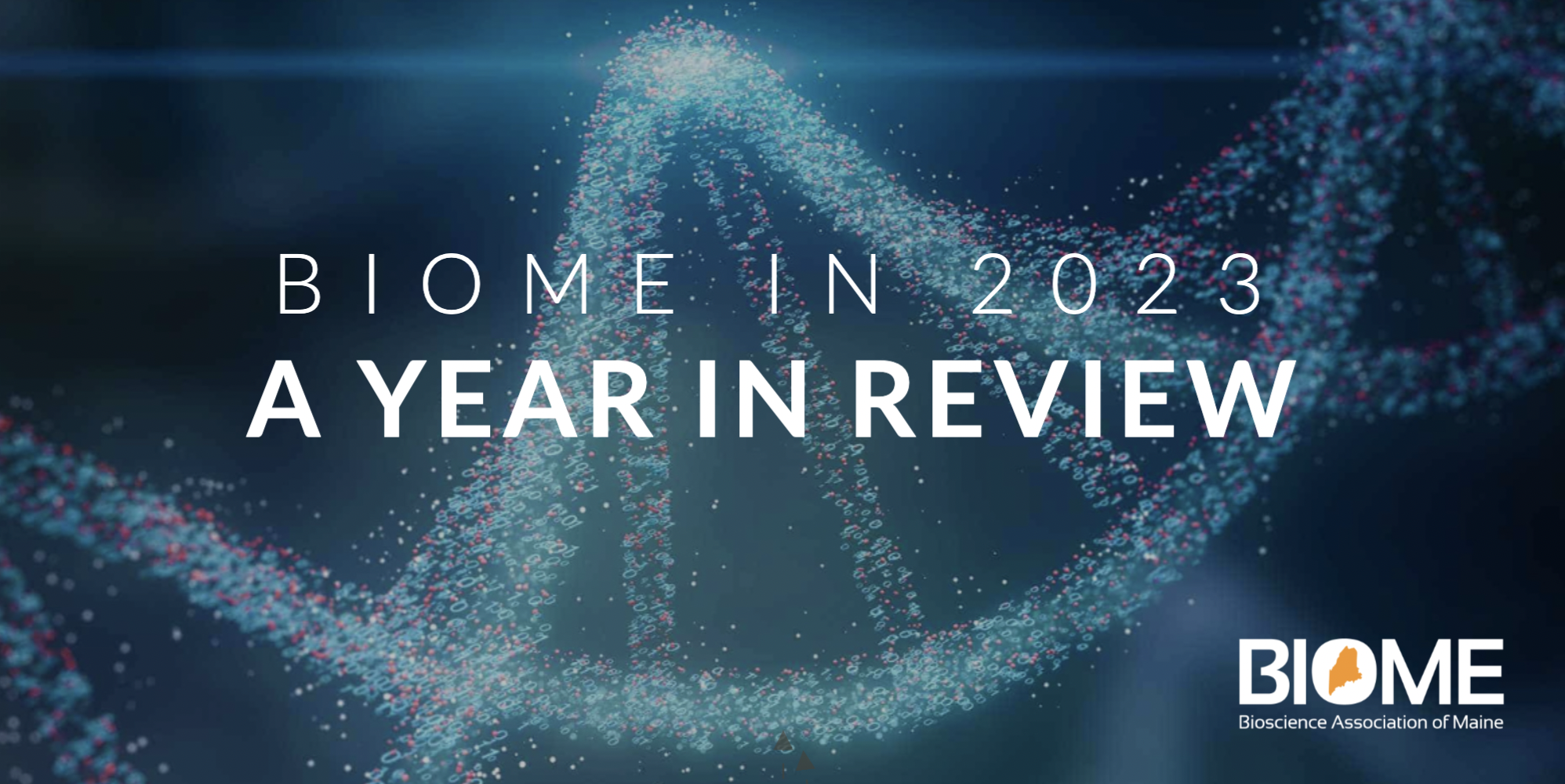ME BioScience Day 2019
On November 21, 2019 we organized our fourth annual ME Bioscience Day at 23 middle schools across the state of Maine. ME BioScience Day is a statewide event that we started as an initiative in 2016. The objective was to get students excited about science and raise awareness of career opportunities in the life sciences sector in Maine.

Bigger and better than before
This year, 58 amazing scientists and life science professionals volunteered to visit local middle school classrooms to talk with students about their career in science, their daily tasks, and inspire Maine’s youth to pursue a career in the field. Volunteers have found that often times students don’t make the connection that life sciences employers offer all sorts of career opportunities, not only for scientists. The bioscience industry has a need for architects, engineers, scientists, marketers, managers, developers, sales professionals and far more. The job diversity of our volunteers helps show students they can aspire to be whatever they want within this industry. In 2018, we were able to reach almost 2,000 students from 14 schools with 22 volunteers from 17 organizations. This year we reached over 3,300 students from 23 schools with 58 volunteers from 26 organizations.

Presentations
Jacob Donahue, a student at the University of Southern Maine, was one of the volunteers to visit Brunswick Junior High. Jacob spent time telling students about his studies, his job as a pharmacy technician and his future goal of attending osteopathic medical school. Jacob also educated students about many non-stereotypical medical professions, such as lab assistants, surgical technicians, phlebotomists, health care managers, etc. Since he was in Brunswick, he informed students that Region 10 High School provides courses in EMT and CNA certification for free. For the hands-on activity, Jacob ran a Hearth Health “Clinic” that discussed the various aspects of cardiovascular health such as blood pressure, heart rate, diet and exercise. Near the end of the presentation, students were invited to make a paper tube stethoscope (representative of stethoscope before the development of the Littman stethoscope). Jacob will even be returning in the spring to demonstrate an immune system model.
Ruth Sexton and Rebecca Champagne, students at the University of Maine, were two of six volunteers at the James F. Doughty School in Bangor. They talked with students about how plants grow and what they need to survive. Each student then filled a cup with soil and planted two succulent cuttings to take home with them. To tie everything together, Ruth and Rebecca brainstormed with students some reasons for why plants are important to us and how that provides numerous opportunities for working in the plant science field.
Dr. Dan Gray, of Gray Optics, was one of the volunteers to visit North Yarmouth Academy. Dr. Gray gave a presentation about biomedical imaging with a focus on optics, mechanics, and electronics. Students learned about how digital microscopes work and each student was able to practice using a surgical laparoscopic camera system. Students were then split up into small groups and were challenged to build their own digital microscope. They used a combination of hand held magnifying glasses and cell phone cameras to capture pictures of leaves at high magnification.
Victoria Kuhn, of Pfizer, was partnered with Audrey Bergeron from MMCRI at King Middle School. They prepared four stations, all with different science experiments. Victoria said students seemed most fascinated with the station that showed lung specimens under microscopes. The microscopes contained cells that were both healthy, as well as cancer cells and compact tumor cells.
Patrick Breeding, of Lobster Unlimited LLC, was another volunteer at James F. Doughty School in Bangor. Patrick presented on varying topics about biomedical engineering in a way middle school students would find interesting. The topics ranged from using photocatalytic nanoparticles for degrading environmental pollutants, to the use of cellulose nanofibers (derived from the pulp and paper industry) for the creation of artificial bone implants, to fluorescence microscopy for analyzing cellular state in anti-cancer studies, to using proteins derived from lobsters for skincare applications. Patrick brought samples of the nanofiber materials for students to handle, and did a quick demonstration on how fluorescence microscopy works by using a blacklight and fluorescent dyes as an example. Patrick finished the presentations by inspiring students to follow their interests within the world of STEM and how that translates into the real world.
Dr. Catherine Miller-Hunt, an Assistant Professor at University of Southern Maine, was one of 5 volunteers who visited Biddeford Middle School for ME Bioscience Day. She started her presentation by briefing Biddeford 8th graders about ticks and mosquitoes in Southern Maine, the diseases that they carry, and how to protect themselves and their pets. Students made the connection that these vector-borne diseases had impacted people in their lives. For the hands-on activity, students played a matching game with pictures of mosquitoes and ticks that would commonly be found in the area. The students divided into teams and matched facts that they had learned in the presentation with pictures of the ticks and mosquitoes. Dr. Miller-Hunt will be returning in the spring to provide classrooms with their own “mosquito breeders”, so classrooms can collect mosquito eggs from the environment and watch the life cycle of the mosquito from the egg to the adult in a safe, enclosed environment.
Rebecca Korbal and Celina Gigliotti, Pharmacy students attending University of New England, also volunteered at Biddeford Middle School. They demonstrated how medications are filled in the pharmacy and how liquid medications are compounded. Rebecca and Celina brought trays from their pharmacy and had students count mini m&ms in groups of fives, so they could get a feel for what it is like to fill medications at a pharmacy. Their second demonstration represented mixing liquid antibiotics by using Hawaiian Punch powder mix. Each student measured the correct amount of water from beakers, added it to the powder and stirred until the powder was dissolved. Finally, they got to enjoy m&ms and beverages they made!

2019 Participating Schools
Mahoney Middle School, South Portland | Memorial Middle School, South Portland | Frank H. Harrison Middle School, Yarmouth | Gorham Middle School, Gorham | James F. Doughty School, Bangor | Sanford Junior High School, Sanford | Saco Middle School, Saco | Scarborough Middle School, Scarborough | Bonney Eagle Middle School, Buxton | Loranger Middle School, Old Orchard Beach | Gray-New Gloucester Middle School, Gray | Biddeford Middle School, Biddeford | North Yarmouth Academy, Yarmouth | Lake Region Middle School, Naples | Cape Elizabeth Middle School, Cape Elizabeth | Winslow Junior High, Winslow | Windham Middle School, Windham | Brunswick Junior High, Brunswick | Lincoln Middle School, Portland | Falmouth Middle School, Falmouth | King Middle School, Portland | Mt. Ararat Middle School, Topsham | The Middle School of the Kennebunks, Kennebunk
2019 Participating Organizations

BioME Scholarships
As a follow up to ME Bioscience Day 2019, BIOME is funding 4 scholarships in the form of 1-week-long summer science camps at the Maine School of Science and Mathematics in Limestone. Eligible students must be age 11-14 and attend one of the schools that participated in ME Bioscience Day 2019. More information will follow.



